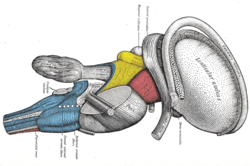Stria terminalis
| Stria terminalis | |
|---|---|
 Dissection of brain-stem. Lateral view (Stria terminalis labeled at upper right.). | |
 Bed nucleus of the stria terminalis of the mouse brain | |
| Details | |
| Identifiers | |
| Latin | stria terminalis |
| NeuroNames | 286 |
| NeuroLex ID | birnlex_937 |
| TA98 | A14.1.09.275 |
| TA2 | 5592 |
| FMA | 61974 |
| Anatomical terms of neuroanatomy | |
The stria terminalis (or terminal stria) is a structure in the brain consisting of a band of fibers running along the lateral margin of the ventricular surface of the thalamus. Serving as a major output pathway of the amygdala, the stria terminalis runs from its centromedial division to the ventromedial nucleus of the hypothalamus.
Anatomy
The stria terminalis covers the superior thalamostriate vein, marking a line of separation between the thalamus and the caudate nucleus as seen upon gross dissection of the ventricles of the brain, viewed from the superior aspect.
The stria terminalis extends from the region of the
Bed nucleus of the stria terminalis (BNST)
The activity of the bed nucleus of the stria terminalis correlates with anxiety in response to threat monitoring.
This nucleus is known to project inhibitory fibers to the lateral hypothalamus and participate in the control of feeding in rodents. Optogenetic activation of this inhibitory pathway rapidly produced voracious feeding behavior in well-fed mice and optogenetic inhibition of this pathway reduces food intake even in starved animals.[6]
Derangement of opioid signaling in the BNST appears to mediate chronic alcohol-induced changes in stress response.
Sexual dimorphism
The central subdivision of the bed nucleus of the stria terminalis (BSTc) is
Hormone replacement therapy has been shown to influence hypothalamic size,[10] even though the study tried to do this by including non-transsexual male and female controls which, for a variety of medical reasons, had experienced hormone reversal.[8] The statement about the neurobiological basis from birth has later been brought to question, though not refuted, by a follow-up study by the same group which found that the sexual dimorphism of the BSTc is not present before adulthood (approximately 22 years of age) even though transsexuals report being aware of their gender identity since childhood.[11]
Since somatostatin-expressing neurons typically block dendritic inputs to the postsynaptic neuron, thus inhibiting signals traveling through associated structures, it is believed that the larger bed nucleus of the stria terminalis found in men (including transgender men) reduce the startle response in men and may be responsible for the higher incidence of specific phobias in women, and a possible source for the stereotype of women being afraid of mice.[12]
Oxytocin receptor activity in the BNST is important for social recognition in rats. Both male and female rats that received a microinjection of oxytocin receptor antagonist had lower social recognition scores than rats that received a vehicle injection, and microinjections of oxytocin into the BNST enhanced social memory in male, but not female, rats.[13]
Reduction of the size of the bed nucleus of the stria terminalis has been observed in
